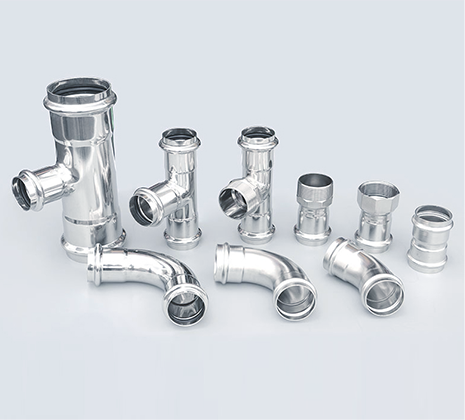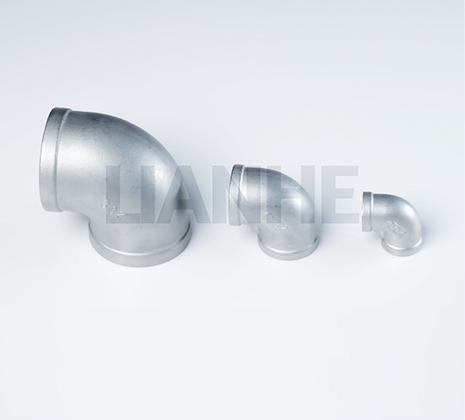Tel: +86-577-86801027 / E-mail: cooper@lianhevf.com
Stainless Steel Fitting
- All
- Product Name
- Product Keyword
- Product Model
- Product Summary
- Product Description
- Multi Field Search
Views: 0 Author: Site Editor Publish Time: 2025-04-17 Origin: Site











Ever wondered why some stainless steel fittings are more expensive than others? 304 and 316 stainless steel fittings look very similar, but they perform quite differently in certain environments. Why does it matter? Because the right material choice could make all the difference between a durable system and costly repairs.
In this post, we’ll break down the differences between 304 stainless steel and 316 stainless steel, helping you understand why one might be better for your project than the other. You’ll learn about their unique properties, applications, and how to choose the right one for your needs.
Before diving into the specifics of 304 and 316 grades, it’s important to understand what stainless steel fittings are and why they’re so widely used. Stainless steel fittings are used to connect, join, and repair pipes in a variety of systems. They can be used in everything from household plumbing to complex industrial systems, offering benefits like corrosion resistance, strength, and durability.
There are many types of stainless steel fittings, but for this discussion, we’ll focus on 304 and 316, two of the most widely used grades. Both are austenitic stainless steels, meaning they have a crystal structure that’s highly resistant to corrosion. However, they each have unique features that make them suitable for different applications.
304 stainless steel is one of the most commonly used stainless steels. It's composed of around 18% chromium and 8% nickel, making it highly resistant to corrosion. This grade is often referred to as "18/8" stainless steel because of its high chromium and nickel content. It’s popular for applications where exposure to corrosive elements isn’t severe.
Corrosion Resistance: 304 stainless steel provides good resistance to corrosion, but it’s not suitable for exposure to highly corrosive substances like saltwater, certain acids, and chlorine.
Strength: 304 stainless steel has a tensile strength of around 500-700 MPa, making it strong enough for most applications, including residential plumbing and light industrial use.
Applications: This grade is used in kitchen appliances, food processing equipment, heat exchangers, and plumbing systems. It’s ideal for environments where exposure to corrosive materials is minimal.
While 304 stainless steel fittings are durable and corrosion-resistant, they may not perform as well in harsh environments, particularly where high levels of chloride or other aggressive chemicals are present.

316 stainless steel is often referred to as “marine grade” stainless steel because of its superior resistance to corrosion, especially in saltwater and chlorinated environments. This grade is very similar to 304 stainless steel, but the key difference lies in the addition of molybdenum (2-3%), which significantly enhances its ability to withstand corrosion, especially in environments with chlorides.
Corrosion Resistance: The addition of molybdenum in 316 stainless steel makes it much more resistant to pitting and crevice corrosion, especially in chloride environments like saltwater and de-icing salts. This makes it an ideal choice for marine and coastal applications.
Strength: Similar to 304 stainless steel, 316 stainless steel offers strong tensile strength and excellent mechanical properties. It’s also highly durable and capable of withstanding extreme conditions.
Applications: 316 stainless steel fittings are commonly used in marine environments, chemical processing plants, pharmaceutical equipment, and other industrial applications where exposure to corrosive substances is high.
In general, 316 stainless steel fittings are more expensive than 304 due to the addition of molybdenum and higher nickel content. However, the extra cost is worth it in harsh or corrosive environments where long-term durability is essential.

The most significant difference between 304 and 316 stainless steel fittings is their corrosion resistance. While both grades are highly resistant to corrosion, 316 stainless steel offers superior resistance, especially in environments with chlorides and other aggressive chemicals. This makes 316 the preferred option for marine and coastal applications or anywhere saltwater is a concern. 304 stainless steel, on the other hand, is best suited for environments that are relatively mild and free of harsh chemicals.
| Property | 304 Stainless Steel | 316 Stainless Steel |
|---|---|---|
| Corrosion Resistance | Good, but not ideal for high chloride exposure | Superior, highly resistant to chlorides and salts |
| Best for | Mild to moderate environments | Harsh, aggressive environments, marine use |
Another key difference is in the chemical composition of the two grades. 304 stainless steel typically contains 18% chromium and 8% nickel, while 316 stainless steel contains 16% chromium, 10% nickel, and 2-3% molybdenum. The addition of molybdenum to 316 is what sets it apart in terms of corrosion resistance, particularly in environments that involve chlorides.
| Element | 304 Stainless Steel | 316 Stainless Steel |
|---|---|---|
| Chromium | 18% - 20% | 16% - 18% |
| Nickel | 8% - 10.5% | 10% - 14% |
| Molybdenum | Trace | 2% - 3% |
The choice between 304 and 316 stainless steel fittings largely depends on the environment where they’ll be used. 304 stainless steel is ideal for general-purpose applications like household plumbing and food processing. 316 stainless steel, however, is the go-to choice for more demanding applications, such as in the marine industry, chemical processing, and pharmaceutical industries where higher levels of corrosion resistance are necessary.
Here’s a breakdown of typical applications for both grades:
| Application | 304 Stainless Steel | 316 Stainless Steel |
|---|---|---|
| Marine and Coastal Environments | Not recommended | Ideal for saltwater exposure |
| Chemical Processing | Mild environments | Harsh chemical exposure |
| Food and Beverage Industry | Yes | Yes |
| Pharmaceutical Equipment | No | Yes |
While 304 stainless steel fittings are generally more affordable than 316, the additional benefits provided by 316 can justify the higher price tag. If you’re operating in an environment where corrosion resistance is critical—such as in marine or chemical industries—the extra cost for 316 stainless steel is a worthwhile investment. However, for lighter, less demanding applications, 304 is a more budget-friendly option.
| Cost Comparison | 304 Stainless Steel | 316 Stainless Steel |
|---|---|---|
| Price | Lower | Higher |
| Best for | Budget-conscious projects | Long-lasting, harsh environments |
Both 304 and 316 stainless steel fittings have excellent formability and are easy to machine, though 316 stainless steel tends to work-harden more quickly. This means 316 stainless steel fittings may require specialized tools and slower machining speeds compared to 304 stainless steel. However, both grades can be welded and formed effectively, making them versatile for a range of applications.
In summary, 304 stainless steel fittings are ideal for general applications, offering good corrosion resistance at a lower cost. However, 316 stainless steel fittings, with added molybdenum, provide superior corrosion resistance, making them the best choice for harsh environments like marine or chemical applications. Choose the right fitting based on the demands of your project for long-term durability and performance.
Visit us for more information on our high-quality stainless steel fittings.
Q: What is the main difference between 304 and 316 stainless steel fittings?
A: The main difference is that 316 stainless steel contains molybdenum, which enhances its resistance to corrosion, especially in environments with chlorides like saltwater. 304 stainless steel is less resistant to these elements.
Q: Are 304 and 316 stainless steel fittings interchangeable?
A: While they can be used in some of the same applications, 316 is better for harsh environments. 304 is a more affordable option for lighter, less corrosive environments.
Q: Can I use 304 stainless steel fittings in marine environments?
A: 304 stainless steel is not recommended for marine environments, as it is not as resistant to saltwater and chlorides as 316 stainless steel.
Q: Why is 316 stainless steel more expensive than 304?
A: 316 stainless steel contains molybdenum, which increases its corrosion resistance but also makes it more expensive than 304.
Q: What industries use 316 stainless steel fittings?
A: 316 stainless steel fittings are commonly used in marine, chemical processing, pharmaceutical, and food processing industries, particularly where high levels of corrosion resistance are required.